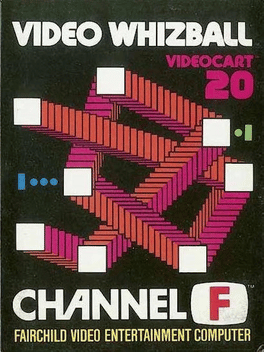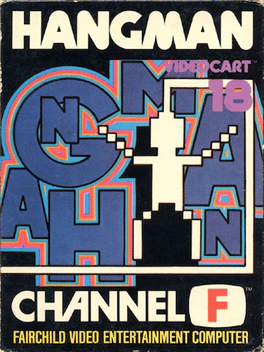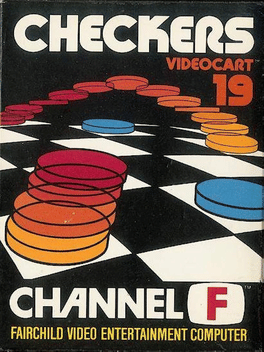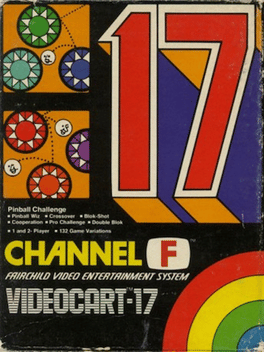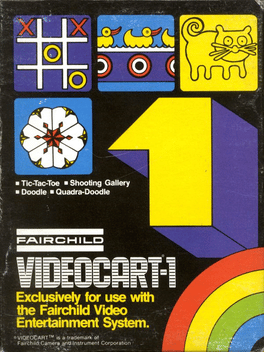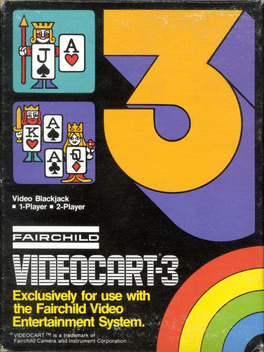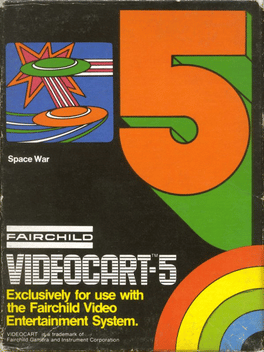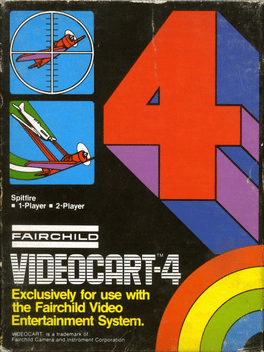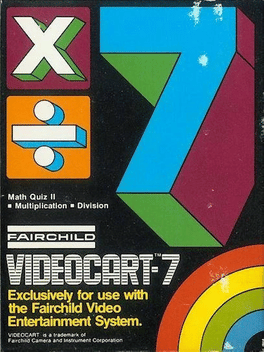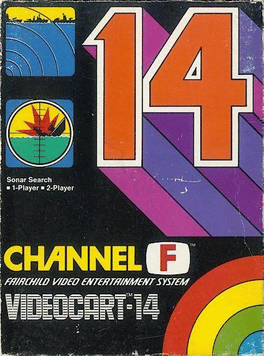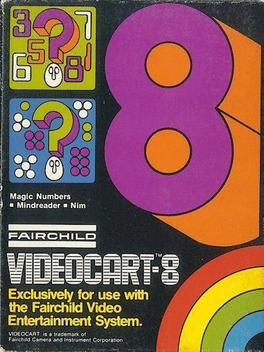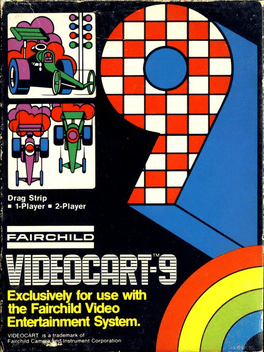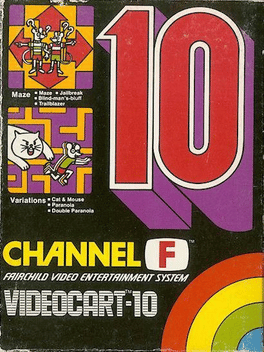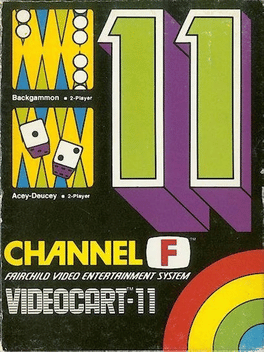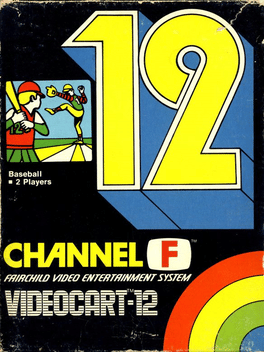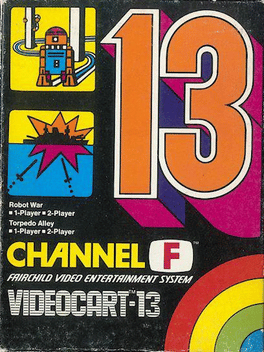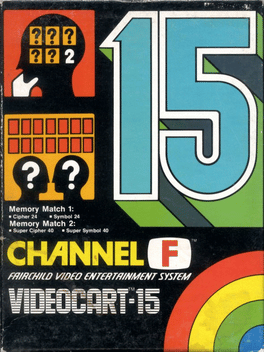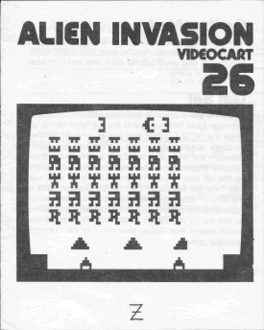Most Popular Fairchild Channel F Games - Page 2
-
Videocart-20: Video Whizball
1978
Video Whizball is a game where players control paddles that have to protect a goal from being entered by whizballs. To protect their goal, the player's paddle can fire missiles which can be aimed straight or angled up or downward. Missiles that hit whizballs can help propel them to start going in an opposite direction. If one of the missiles or whizballs hits the player's or the opponent's paddle, it will temporarily disappear leaving the respective goal undefended. The game is won when either one of the players gets to a previously selected score. The game contains 72 game variations of this basic premise. Variations include having from 1 to 4 whizballs, and 6 different game types: Basic: each whizball is worth only 1 point; Basic Plus: players can guide the missile shots into the whizballs; Bonus: whizballs can be numbered 1 through 4 and are worth that many points each; Bonus Plus: adds guided missiles to the Bonus game type; Super Bonus: whizballs increase in value from 1 to 9 points the longer they stay in pl -
Videocart-18: Hangman
1978
The classic game of Hangman, in which the player has to guess a hidden word by suggesting letters. Only a certain number of letters can be tried - every incorrect guess will add an element to a drawing of a man being hanged at the gallows. The player loses if the drawing gets complete, due to his missing attempts at finding the letters in the secret word. The game contains 64 game variations of this basic premise for either 1 or 2 players, with or without a score. Variations include: The computer selects the word to guess; One player comes up with a word for another player to solve; The player is given one of the letters in the word to help him get started; The game will tell the player he guessed the right letter but will not say where it belongs in a word; The player isn't told how long the secret word is; The player has to guess the letters and their location in the word; The player has to solve an anagram. -
Videocart-19: Checkers
1978
A playable version of the board game of Checkers. The player controls the 12 checkers at the bottom of the screen and attempts to remove the 12 checkers at the top of the screen, controlled by the computer. A player can only move his checkers diagonally toward his opponent's side of the board. A checker can be jumped when two opposing checkers are adjacent to each other and there is an empty space directly across the checker being jumped. If there's a checker in the board that a player can jump, he is forced to do so. If a checker reaches the other side of the board, that checker is kinged and is allowed to move and jump both back and forth in diagonal movements. The game is won by the player who removes all of his opponent's checkers from the board. This preprogrammed cartridge plugs into the console of the Fairchild Video Entertainment System for more TV fun on the Channel F Network. The classic game of checkers is played against the computer. Here is your chance to sharpen your skills without your opponent dump -
Videocart-17: Pinball Challenge
1978
Although the title of the game may lead players to believe it's a pinball game, this is actually a Breakout variant. The basic gameplay features the player bouncing a ball off of a paddle into a wall of bricks, chipping them off one brick at a time. Each brick destroyed earns the player points with the low green bricks being worth 1 point each, the middle blue bricks being worth 4 points each, and the red bricks on top rewarding 7 points each. Once the ball bounces off the wall of bricks, it's up to the player to maneuver the paddle under the falling ball in order to hit it back up into the wall of bricks. The player loses a life if he happens to miss hitting the ball with his paddle and it falls into the abyss. The game ends when 7 balls are lost. To keep up with the pinball motif, the wall of bricks are referred to as different colored skill lanes, the walls on the side that the ball can bounce off of are labeled side rails, and the paddle is referred to as a flipper. The game offers 132 game variations of this -
Videocart-22: Slot Machine
1980
In this slot machine simulation, the player can choose the starting purse (from 1-99 USD) and then bet on each spin of the slot reels. The game offers two modes: Random play lets the wheel spin and then stop randomly, and select play lets the player choose when to stop each wheel at a time. -
Videocart-1: Tic-Tac-Toe & Shooting Gallery & Doodle & Quadra-Doodle
1976
Videocart-1: Tic Tac Toe, Shooting Gallery, Doodle, Quadradoodle is a board game genre video game released in 1976 by Fairchild Semiconductor for the Fairchild Channel F. This preprogrammed cartridge plugs into the console of the Fairchild Video Entertainment System for more TV fun with these exciting solo games. -
Videocart-2: Desert Fox & Shooting Gallery
1976
Videocart-2: Desert Fox &Shooting Gallery is action/shooter genre video game released in 1976 by Fairchild Semiconductor for the Fairchild Channel F. Stalk a foxy enemy or knock off a few ducks. Let out your hunter instincts with these two exciting games. -
Videocart-3: Video Blackjack
1976
Videocart 3: Video Blackjack is a Casino video game released by Fairchild Semiconductor for the Fairchild Channel F in 1976. Think your system's unbeatable? Wait'll you see ours! Deal yourself into Video Blackjack for some fast action before you hit the big time. -
Videocart-5: Space War
1977
Videocart-5: Space War is a Shoot 'em up released by Fairchild Semiconductor for the Fairchild Channel F in 1977. This preprogrammed cartridge plugs into the console of the Fairchild Video Entertainment System for more TV fun. Teleport yourself and a friend to an interstellar battleground with this "faster - than - the - speed - of - light" game. -
Videocart-4: Spitfire
1977
Videocart-4: Spitfire is a 1 on 1 aerial dogfighting Shooter game released by Fairchild Semiconductor for the Fairchild Channel F in 1977. In addition to a 2 player mode the game allowed for 1 player to combat the CPU, which for the time was unique for a home console thanks to the Channel F being the first home console with a CPU. This preprogrammed cartridge plugs into the console of the Fairchild Video Entertainment System for more TV fun. Join up and get ready for the toughest dogfights since the Great Air War in 1 and 2- player versions of Spitfire. -
Videocart-7: Math Quiz II - Multiplication & Division
1977
Videocart-7: Math Quiz (Multiplication & Division) is a Triva/Game/Quiz Show video game released by Fairchild Semiconductor for the Fairchild Channel F in 1977. This preprogrammed cartridge plugs into the console of the Fairchild Video Entertainment System for more TV fun. Get one problem right and a new one appears. Take turns with a buddy to double the competition... And quadruple the fun! -
Videocart-14: Sonar Search
1978
Sonar Search features the basic gameplay idea of Battleship, but with a unique twist. Instead of trying to randomly guess what grid an opponent's battleship is on, after the player takes a shot, the player will hear a sonar ping noise. The shorter the noise, the closer the player is to hitting a target. In the 1 player game, the player has a limited number of chances to sink the enemy fleet of ships, while in the 2 player game, players take turns trying to sink their opponents ships before having their own ships sunk. This preprogrammed cartridge plugs into the console of the Fairchild Video Entertainment System for more TV fun. This battle on the high seas is sure to score a direct hit with exciting one and two-player games. -
Videocart-8: Magic Numbers - Mind Reader & Nim
1977
Mind Reader is a one-player game, you against the computer. The object is to guess the number the computer is thinking of. The number can be 2 to 5 digits long. You have 20 guesses or a time limit. Also in Nim you play against the computer. You have a choice of 3, 6, or 9 piles. The objects in the piles are numbers, 1 to 15. The player who takes the last number off the screen wins. -
Videocart-9: Drag Strip
1977
This drag racing simulator makes use of the Channel F's special controllers. While twisting the joystick's head to the left or right controls the engine throttle, the stick movement itself is used to shift gears in a realistic H-pattern. Depending on the chosen skill level, the car available is a family sedan, a modified sedan, a funny car, or a real dragster, although they all look the same on screen. One player can try to beat the predefined par time of 7.7 seconds, or compete against a friend to see who reaches the finish line first. The game manual mentions that a player only wins the game when he brings his victory counter to 99. This preprogrammed cartridge plugs into the console of the Fairchild Video Entertainment System for more TV fun. Know when to shift and you'll go the distance with these 2 racy games. But careful... Redline your engine, an dyou wind up shiftless! (You've blown it!) -
Videocart-10: Maze, Cat and Mouse
1977
Poor little mice, doomed to run around in a maze and escape as quickly as they can. As if that's not enough, the owners of this maze pit you against a friend to see who will escape first. And then the diabolical owners take it one step further and add a cat to the maze mix - forcing you not only to escape first, but escape alive! In this Videocart Maze: A straight maze run. Jailbreak: The maze is a grid with hidden passages. Blind-man's-bluff: The maze is invisible and no walls can ever be seen. Trailblazer: The maze is invisible but the rats leave a trail on their path. There are also a few game modes: Regular Maze: Two players race each other out of the maze. Cat and Mouse: The computer controls a cat that chases the mice. There are 4 different speeds for the cat. Paranoia: Neither mouse can leave the maze until the other one is caught by the cat. Double Paranoia: There's no cat and neither mouse can leave the maze, allowing the players to practice or experiment play modes. This preprogrammed cartridge plugs i -
Videocart-11: Backgammon, Acey-Deucey
1977
The original game of backgammon for the first 2nd-generation console of 1977. Players take turn rolling dice and then moving their pieces around the game board. Blue & Red each have to move all their pieces off the board to win, and are competing against each other and against lady luck herself. Acey-Deucey is another way to play Backgammon where the starting position is different. Instead of starting the game with numerous pieces arranged at places around the board, you start with all your pieces at the starting line. It makes for a longer game, although just as strategic and challenging. This preprogrammed cartridge plugs into the console of the Fairchild Video Entertainment System for more TV fun. This time, play the world's newest and most modern game of backgammon. The pieces are on the tube, rather than a board. Like the regular game, but better... You've got nothing to lose! -
Videocart-12: Baseball
1977
One player takes to the field, the other grabs a bat and steps up to the plate. The pitcher can throw fast, slow, and some wicked curves even at the last moment. Luckily the single-button swing action makes hitting the ball fairly easy, even if getting a single is harder than hitting a double or home-run. This preprogrammed cartridge plugs into the console of the Fairchild Video Entertainment System for more TV fun. Our Baseball game gives you nine (or more) innings to practice your timing, mix-up your pitches, shift your outfield... major league thrills with the comforts of home. (Tinkers to Evers never had such a Chance!) -
Videocart-13: Robot War, Torpedo Alley
1977
This cart contains two different games. The first game is Robot War. It takes place on a space station. The computer malfunctioned and now four robots are out to hunt down the player. Gameplay mainly has the player trying to trick the pursuing robots into one of the four electrified force fields littered throughout the playfield. Every time the player is touched by a robot, one of the force fields disappear. Once all the force fields disappear, the player loses a point to the robots. If all the robots are defeated, the player gets a point for that round. The game also features an option for two players, where the second player takes control of the robots. The game features four game speeds from slowest to fastest The other game is Torpedo Alley. Players control a shore battery at the bottom of the screen and shoot at an invading fleet of ships above them. Each hit ship is worth a different amount of points, with the lowest ship being worth 1 point, the middle ship worth 3 points, and the highest ship worth 5 poin -
Videocart-15: Memory Match
1978
Memory Match is a game where the player is given the task of flipping over cards two at a time in the hopes of having them match. If the cards match, they disappear from the playfield. If they don't match, the cards are flipped back over face down and the player tries again. The better the player is at memorizing where the overturned cards were, the easier it will be for him to find a match. The game contains 4 variations of its basic premise. The Memory Match 1 variations offer a smaller grid thus making it easier. Memory Match 1: Cipher-24 (6x4 grid with numbers) Symbol-24 (6x4 grid with symbols) Memory Match 2: Super Cipher-40 (10x4 grid with numbers) Super symbol-40 (10x4 grid with symbols) The game offers both 1 and 2-player modes. When playing alone, the player tries to clear the board in the fewest amount of guesses. In the multiplayer, both players try to get more matches than their opponent. -
Videocart-26: Alien Invasion
1981
In this Space Invaders variant, the player controls a gun turret at the bottom of the screen and fires missiles at incoming alien ships. The turret can move both left and right and hide behind three protective barriers. The alien invaders move left and right, fire missiles at the player, and slowly approach the planet surface - if they land, the player loses the game. Every once in a while, an alien mothership will fly across the top of the screen and shooting it will give the player extra points. The goal of the game is to destroy all alien ships in each attacking wave and score as many points as possible. The game ends when players lose their three lives.
